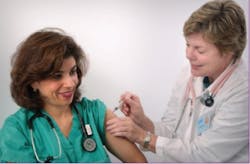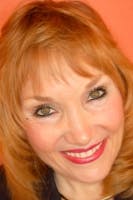Surviving malignant melanoma
By Laura A. Mallery-Sayre, RDH, MSDHEd
In May of 2010, a small brown mole that had been on my thigh since birth started feeling intermittently itchy without changes in color, size, or shape. Intuition, as well as my medical background, told me that this should not be happening. Since my husband had just had a serious experience with skin cancer six months before, I quickly made an appointment with our dermatologist. I routinely see her every six months, so I wasn’t overly concerned but wanted to be proactive. After a punch biopsy to be on the safe side, I went happily about my busy routine for the next week.
In May of 2010, a small brown mole that had been on my thigh since birth started feeling intermittently itchy without changes in color, size, or shape. Intuition, as well as my medical background, told me that this should not be happening. Since my husband had just had a serious experience with skin cancer six months before, I quickly made an appointment with our dermatologist. I routinely see her every six months, so I wasn’t overly concerned but wanted to be proactive. After a punch biopsy to be on the safe side, I went happily about my busy routine for the next week.
Laura Mallery-Sayre and Frank Sayre, DDS
The morning of my diagnosis, I awoke from a dream that was all too real. I woke up my husband with “Oh, my gosh, Monica called me in my dream and told me that I had a malignant melanoma!” This had not even consciously occurred to me as a possibility. As soon as the dermatology office opened, I phoned the office to find out about the biopsy report. The secretary said that they had received it the night before and that Dr. Scheel would be calling me at noon to discuss the findings. I told her of my dream and I heard her catch her breath. For the next four hours, I was immobilized. I kept telling myself that no one in my family had ever had malignant melanoma. I wasn’t genetically vulnerable. Among women, melanoma is the seventh most common type of cancer with more than 27,000 cases diagnosed in the U.S. every year. Women under 40 have a higher probability of developing melanoma than any other cancer except breast cancer. The call confirmed that the dream was accurate.
The morning of my diagnosis, I awoke from a dream that was all too real. I woke up my husband with “Oh, my gosh, Monica called me in my dream and told me that I had a malignant melanoma!” This had not even consciously occurred to me as a possibility. As soon as the dermatology office opened, I phoned the office to find out about the biopsy report. The secretary said that they had received it the night before and that Dr. Scheel would be calling me at noon to discuss the findings. I told her of my dream and I heard her catch her breath. For the next four hours, I was immobilized. I kept telling myself that no one in my family had ever had malignant melanoma. I wasn’t genetically vulnerable. Among women, melanoma is the seventh most common type of cancer with more than 27,000 cases diagnosed in the U.S. every year. Women under 40 have a higher probability of developing melanoma than any other cancer except breast cancer. The call confirmed that the dream was accurate.
The good news is that my awareness of my body and my quick actions provided me with the best chance of survival. The melanoma was from UV sun damage (years of marathon training in Hawaii). The Breslow’s thickness was less than 1 mm giving me a 95 to 100% chance of a 5-year survival rate, and the margins were clean with just the punch biopsy.** After having six inches of my thigh removed, it was determined that there were no satellite cells! Two years later, without having to have any lymph nodes removed, any chemotherapy or radiation, I have graduated to a yearly examination by my oncologist. I’m a survivor!Lessons learned: SPF sunscreen denatures around two hours and needs to be reapplied, examine your body and act fast. There is only a 15 % survival rate if melanoma goes to stage four.
***No Ad sunscreen takes top honors from Consumer Reports
Laura A. Mallery-Sayre, RDH, MSDHEd, graduated in 1969 from The University of Oregon Dental School and received her master’s degree from Old Dominion University. **Editor’s Note: Breslow's depth was used as a prognostic factor in melanoma of the skin. It is a description of how deeply tumor cells have invaded. Currently, the standard Breslow's depth has been replaced by the AJCC depth. First reported by Alexander Breslow, MD, in 1970, the Breslow thickness is defined as the total vertical height of the melanoma, from the very top (called the "granular layer") to the area of deepest penetration in to the skin. An instrument called an "ocular micrometer" is used to measure the thickness of the excised (removed) tumor. In general, the higher the Breslow thickness, the worse the prognosis. However, these survival rates are averages and may not reflect individual cases): Less than 1 mm: 5-year survival is 95% to 100%; 1 to 2 mm: 5-year survival is 80% to 96%; 2.1 to 4 mm: 5-year survival is 60% to 75%; Greater than 4 mm: 5-year survival is 37% to 50%.***Editor's Note: Consumer Reports tested 19 sunscreens, out of those tested only 7 were found to protect against UVA and UVB rays. The top rated sunscreens according to the consumer-watchdog group for the best price were No-Ad with Aloe & Vitamin E SPF 45 and Walgreens Continuous Spray Sport SPF 50.Overall, the sunscreens they recommend for the best protection from the sun are All Terrain AquaSport SPF 30, Banana Boat Clear UltraMist Sport Performance Active Dry Protect SPF 30, Coppertone Sport High Performance Ultra Sweatproof SPF 30, Eco All Natural Sunscreen Body SPF 30, and Coppertone Oil Free Foaming SPF 75+. The sunscreens to steer clear from this summer are Hawaiian Tropic Sheer Touch Creme Lotion SPF 50, Banana Boat Kids Tear-Free Sting-Free SPF 50, and Alba Botanica Natural Very Emollient Sunblock Sport SPF. These sunscreens were rated the worst based on their low protection against UVA radiation, which causes signs of aging and increased risk of skin cancer. The FDA is requiring new labeling and testing so that sunscreens that claim to be broad spectrum will have to prove that they protect against UVA rays as well as UVB rays. This new regulation will go into effect this December. For more info go to consumerreports.org.




